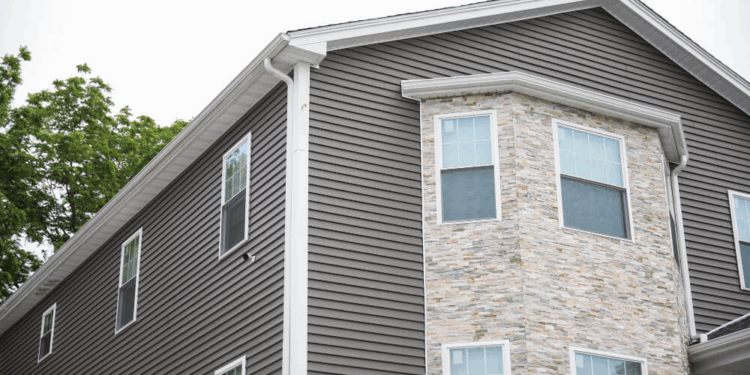
Delving into the realm of siding world, this guide aims to provide a detailed overview of various aspects related to siding materials, installation processes, maintenance tips, and current trends. Each section offers valuable insights to help readers navigate the world of siding with ease.
As we unravel the intricacies of siding, readers will gain a deeper understanding of the different types of materials, the installation procedures, maintenance practices, and the latest trends shaping the industry.
Types of Siding Materials
When it comes to siding materials for construction projects, there are several options available in the market. Each type of siding material comes with its own set of pros and cons, which can impact factors such as cost, durability, maintenance, and aesthetics.
Vinyl Siding
Vinyl siding is one of the most popular choices due to its affordability and low maintenance requirements. It is available in a wide range of colors and styles, making it a versatile option for many homeowners. However, vinyl siding may not be as durable as other materials, and it can crack or fade over time.
Wood Siding
Wood siding offers a classic and natural look that many homeowners find appealing. It is environmentally friendly and can be easily painted or stained to match your desired aesthetic. However, wood siding requires regular maintenance, such as painting or sealing, to prevent rot, warping, or insect damage.
Fiber Cement Siding
Fiber cement siding is a durable option that is resistant to fire, moisture, and pests. It can mimic the look of wood or masonry without the same level of maintenance. Although fiber cement siding is heavier and more expensive than vinyl, it can last for many years with minimal upkeep.
Metal Siding
Metal siding, such as aluminum or steel, is known for its strength and longevity. It is resistant to rot, insects, and fire, making it a durable choice for harsh climates. However, metal siding may dent easily and require repainting over time to maintain its appearance.Overall, the choice of siding material will depend on factors such as budget, maintenance preferences, and the desired aesthetic for your property.
It is essential to weigh the pros and cons of each option carefully before making a decision.
Siding Installation Process
Installing siding on a residential building is a crucial step in enhancing its curb appeal and protecting it from the elements. The process requires attention to detail and the use of proper tools and equipment to ensure a seamless and professional finish.
Tools and Equipment Required
- Hammer
- Nails or screws
- Tape measure
- Level
- Saw
- Siding cutter
- Ladder
- Caulk gun
Importance of Proper Insulation and Waterproofing
Proper insulation and waterproofing play a vital role in ensuring the longevity of the siding and protecting the underlying structure from moisture damage. Without adequate insulation and waterproofing, the siding may not perform optimally and could lead to issues such as mold growth and structural damage.
Tips for a Seamless Installation
- Start by preparing the surface and ensuring it is clean and free of debris.
- Measure and cut the siding to fit accurately, allowing for expansion and contraction.
- Use a level to ensure the siding is installed straight and evenly across the building.
- Secure the siding in place using nails or screws at the designated intervals.
- Apply caulking around windows, doors, and corners to prevent water infiltration.
- Finish the installation by adding trim pieces for a polished look.
Siding Maintenance Tips
Maintaining your siding is crucial to ensuring its longevity and keeping your home looking its best. By following some simple maintenance tips, you can prevent common issues and preserve the beauty of your siding for years to come
Regular Cleaning and Inspection
Regularly cleaning your siding is essential to prevent dirt, mold, and mildew buildup. For vinyl siding, use a mixture of water and mild detergent to scrub away any grime. For wood siding, be cautious with pressure washing and opt for a gentle cleaning solution to avoid damaging the wood.
Inspect your siding annually for any signs of damage, such as cracks, rot, or loose panels, and address them promptly to prevent further issues.
Addressing Common Issues
Common issues with siding include mold growth, moisture infiltration, and warping. To address mold, use a solution of water and bleach to clean affected areas. Ensure proper ventilation to prevent moisture buildup, which can lead to rot and warping. If you notice any signs of damage, such as soft spots or discoloration, take action immediately to prevent further deterioration.
Cleaning Different Siding Materials
Different siding materials require specific cleaning methods to maintain their appearance. For fiber cement siding, use a soft brush and soapy water to scrub away dirt and grime. Aluminum siding can be cleaned with a mixture of water and vinegar to remove oxidation stains.
Consult the manufacturer's guidelines for the best cleaning practices for your specific siding material.
Importance of Regular Maintenance
Regular maintenance not only keeps your siding looking great but also helps prolong its lifespan. By addressing issues promptly and conducting routine inspections, you can prevent costly repairs and ensure your siding remains in top condition for years to come.
Siding World Trends
In the ever-evolving world of siding design and aesthetics, several trends have emerged that are shaping the industry. From eco-friendly options to technological advancements, the siding world is constantly adapting to meet the demands of modern homeowners.
Eco-Friendly Siding Options
As sustainability becomes a top priority for many consumers, eco-friendly siding options have gained popularity in the market. Materials such as reclaimed wood, recycled vinyl, and fiber cement offer homeowners a greener alternative without compromising on style or durability.
Impact of Technology
Advancements in technology have revolutionized modern siding materials and installation techniques. From innovative coatings that resist fading and warping to virtual reality tools that help visualize the final look of a home, technology is reshaping the way siding is designed and installed.
Innovative Siding Products
Innovative siding products are making waves in the market, offering unique aesthetics and enhanced performance. Products like metal shingles, engineered wood siding, and stone veneer are gaining popularity for their durability, versatility, and modern appeal.
Last Point
In conclusion, the world of siding is a dynamic and evolving domain that offers a myriad of options for homeowners and professionals alike. By staying informed about the latest trends and best practices, individuals can make informed decisions when it comes to siding projects, ensuring both aesthetic appeal and functionality for years to come.
Questions Often Asked
What are the most common types of siding materials used?
The most common types of siding materials include vinyl, wood, fiber cement, and metal, each offering unique benefits and drawbacks.
What tools are essential for siding installation?
Tools such as a hammer, nails, level, tape measure, and saw are essential for proper siding installation.
How often should siding be inspected for maintenance?
It is recommended to inspect siding at least once a year for any signs of damage or wear that may require repairs.













